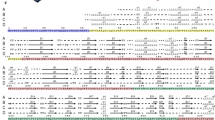Summary
Infection ofDrosophila cells with Cricket paralysis virus in the presence of Actinomycin D results in virtual complete inhibition of host cell protein synthesis by four hours post-infection. Using35S-methionine or14C-amino acids to pulse infected cells three major classes of viral induced proteins can be detected, (A) high molecular weight precursor proteins, (B) viral structural proteins and (C) low molecular weight cleavage products. The large number of high molecular weight proteins found in the infected cells suggests that a multiple cleavage cascade mechanism is partially utilized to produce virus structural proteins. In infected cells, even with short pulses, the largest viral induced protein obtained has a molecular weight of 144,000. However with pretreatment of the infected cells with iodoacetamide before pulsing, two further proteins are obtained with molecular weights of 205,000 and 190,000. Other changes occur in viral protein precursors in the presence of iodoacetamide.
Similar content being viewed by others
References
Butterworth, B. E., Korant, B. D.: Characterization of the large picornaviral 1 polypeptides produced in the presence of zinc ions. J. Virol.14, 282–291 (1974).
Fenner, F.: Classification and nomenclature of viruses. Second report of the International Committee on Taxonomy of Viruses. Intervirol.7, 1–115 (1976).
Jacobson, M. F., Asso, J., Baltimore, D.: Further evidence on the formation of poliovirus proteins. J. mol. Biol.49, 657–669 (1970).
Laemmli, U. K.: Cleavage of structural proteins during the assembly of the head of bacteriophage T4. Nature (London)227, 680–685 (1970).
Laskey, R., Mills, A.: Quantitative film detection of3H and14C in polyacrylamide gels by fluorography. Europ. J. Biochem.56, 335–341 (1975).
Longworth, J. F.: Small isometric viruses of invertebrates. Adv. Virus Res.23, 103–157 (1978).
Lowry, O. H., Rosebrough, N. J., Farr, A. L., Randall, R. J.: Protein measurement with the Folin phenol reagent. J. biol. Chem.193, 264–275 (1951).
Lucas-Lenard, J.: Cleavage of mengovirus polyproteinsin vivo. J. Virol.14, 261–269 (1974).
Marchesi, V. T., Furthmayr, H., Tomita, M.: The red cell membrane. Ann. Rev. Biochem.45, 667–698 (1976).
Matthews, R. E. F.: Third report of the International Committee on Taxonomy of viruses. Intervirol.12, 132–296 (1979).
Moore, N. F., Kearns, A., Pullin, J. S. K.: Characterization of cricket paralysis virus-induced polypeptides inDrosophila cells. J. Virol.33, 1–9 (1980).
Palmenberg, A. C., Pallansch, M. A., Rueckert, R. R.: Protease required for processing picornoviral coat protein residues in the viral replicase gene. J. Virol.32, 770–778 (1979).
Paucha, E., Seehafter, J., Colter, J. S.: Synthesis of viral specific polypeptides in mengovirus-infected L-cells: evidence for asymmetric translation of the viral genome. Virology61, 315–326 (1974).
Plus, N., Croizier, G., Reinganum, C., Scotti, P. D.: Cricket paralysis virus andDrosophila C virus: serological analysis and comparison of capsid polypeptides and host range. J. Invert. Pathol.31, 296–302 (1978).
Reinganum, C.: The isolation of Cricket paralysis virus from the emperor gum moth,Antheraea eucalytpi Scott, and its infectivity towards a range of insect species. Intervirol.5, 97–102 (1975).
Reinganum, C., O'Loughlin, G. T., Hogan, T. W.: A non-occluded virus of the field cricketsTeleogryllus oceanicus andT. commodus (Orthoptera: Gryllida). J. Invertebr. Pathol.16, 214–220 (1970).
Rueckert, R. R.: On the structure and morphogenesis of picornaviruses, 131 to 213. In:Fraenkel-Conrat, Wagner, R. R. (eds.), Comprehensive. Virology, Vol. 6. New York: Plenum Publishing Corp. 1976.
Author information
Authors and Affiliations
Additional information
With 4 Figures
Rights and permissions
About this article
Cite this article
Moore, N.F., Reavy, B. & Pullin, J.S.K. Processing of Cricket paralysis virus induced polypeptides inDrosophila cells: Production of high molecular weight polypeptides by treatment with iodoacetamide. Archives of Virology 68, 1–8 (1981). https://doi.org/10.1007/BF01315161
Received:
Accepted:
Issue Date:
DOI: https://doi.org/10.1007/BF01315161




